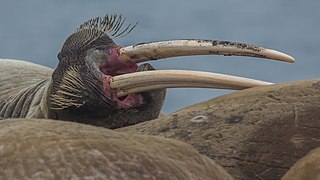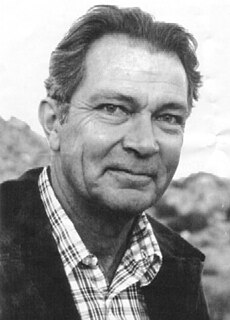Related Research Articles

Plankton are the diverse collection of organisms found in water that are unable to propel themselves against a current. The individual organisms constituting plankton are called plankters. In the ocean, they provide a crucial source of food to many small and large aquatic organisms, such as bivalves, fish and whales.

Oyster is the common name for a number of different families of salt-water bivalve molluscs that live in marine or brackish habitats. In some species, the valves are highly calcified, and many are somewhat irregular in shape. Many, but not all oysters are in the superfamily Ostreoidea.

Bivalvia, in previous centuries referred to as the Lamellibranchiata and Pelecypoda, is a class of marine and freshwater molluscs that have laterally compressed bodies enclosed by a shell consisting of two hinged parts. Bivalves as a group have no head and they lack some usual molluscan organs like the radula and the odontophore. They include the clams, oysters, cockles, mussels, scallops, and numerous other families that live in saltwater, as well as a number of families that live in freshwater. The majority are filter feeders. The gills have evolved into ctenidia, specialised organs for feeding and breathing. Most bivalves bury themselves in sediment where they are relatively safe from predation. Others lie on the sea floor or attach themselves to rocks or other hard surfaces. Some bivalves, such as the scallops and file shells, can swim. The shipworms bore into wood, clay, or stone and live inside these substances.

Riftia pachyptila, commonly known as the giant tube worm, is a marine invertebrate in the phylum Annelida related to tube worms commonly found in the intertidal and pelagic zones. R. pachyptila lives on the floor of the Pacific Ocean near hydrothermal vents, and can tolerate extremely high hydrogen sulfide levels. These worms can reach a length of 3 m, and their tubular bodies have a diameter of 4 cm (1.6 in). Ambient temperature in their natural environment ranges from 2 to 30°C.

Bioturbation is defined as the reworking of soils and sediments by animals or plants. These include burrowing, ingestion, and defecation of sediment grains. Bioturbating activities have a profound effect on the environment and are thought to be a primary driver of biodiversity. The formal study of bioturbation began in the 1800s by Charles Darwin experimenting in his garden. The disruption of aquatic sediments and terrestrial soils through bioturbating activities provides significant ecosystem services. These include the alteration of nutrients in aquatic sediment and overlying water, shelter to other species in the form of burrows in terrestrial and water ecosystems, and soil production on land.

The Pacific oyster, Japanese oyster, or Miyagi oyster, is an oyster native to the Pacific coast of Asia. It has become an introduced species in North America, Australia, Europe, and New Zealand.
Thorson's rule is an ecogeographical rule which states that benthic marine invertebrates at low latitudes tend to produce large numbers of eggs developing to pelagic and widely dispersing larvae, whereas at high latitudes such organisms tend to produce fewer and larger lecithotrophic (yolk-feeding) eggs and larger offspring, often by viviparity or ovoviviparity, which are often brooded.

The Unionidae are a family of freshwater mussels, the largest in the order Unionida, the bivalve molluscs sometimes known as river mussels, or simply as unionids.
Comparative physiology is a subdiscipline of physiology that studies and exploits the diversity of functional characteristics of various kinds of organisms. It is closely related to evolutionary physiology and environmental physiology. Many universities offer undergraduate courses that cover comparative aspects of animal physiology. According to Clifford Ladd Prosser, "Comparative Physiology is not so much a defined discipline as a viewpoint, a philosophy."
Marine larval ecology is the study of the factors influencing dispersing larvae, which many marine invertebrates and fishes have. Marine animals with a larva typically release many larvae into the water column, where the larvae develop before metamorphosing into adults.
Paul Kwan Chien is a Chinese-American biologist known for his research on the physiology and ecology of intertidal organisms and his support for the pseudosciences of intelligent design and creationism.

Michael Alan Rice, is an American professor of fisheries and aquaculture at the University of Rhode Island and former state representative from South Kingstown, Rhode Island. A Democrat, he served in the Rhode Island House of Representatives, representing the 35th district, encompassing the village of Kingston and West Kingston, and parts of the neighborhoods of Tuckertown, Wakefield and Peace Dale. Rice was first elected in November 4, 2008 and served from January 6, 2009 to January 4, 2011.

Grover Cleveland Stephens, Jr., was an American marine biologist and comparative physiologist at the University of Minnesota and the University of California, Irvine.

Parborlasia corrugatus is a proboscis worm in the family Cerebratulidae. This species of proboscis or ribbon worm can grow to 2 metres in length, and lives in marine environments down to 3,590 metres (11,780 ft). This scavenger and predator is widely distributed in cold southern oceans.

Shell growth in estuaries is an aspect of marine biology that has attracted a number of scientific research studies. Many groups of marine organisms produce calcified exoskeletons, commonly known as shells, hard calcium carbonate structures which the organisms rely on for various specialized structural and defensive purposes. The rate at which these shells form is greatly influenced by physical and chemical characteristics of the water in which these organisms live. Estuaries are dynamic habitats which expose their inhabitants to a wide array of rapidly changing physical conditions, exaggerating the differences in physical and chemical properties of the water.
Vibrio tubiashii is a Gram-negative, rod-shaped (0.5 um-1.5 um) marine bacterium that uses a single polar flagellum for motility. It has been implicated in several diseases of marine organisms.

Joseph Richard Pawlik is a marine biologist. He is the Frank Hawkins Kenan Distinguished Professor of Marine Biology in the Department of Biology and Marine Biology at the University of North Carolina Wilmington. He is best known for studies of sponges on Caribbean coral reefs that reveal ecological principles such as resource trade-offs, trophic cascades and indirect effects.

The Arctic ocean covers an area of 14,056,000 squared kilometers, and supports a diverse and important socioeconomic food web of organisms, despite its average water temperature being 32 degrees Fahrenheit. Over the last three decades, the Arctic Ocean has experienced drastic changes due to climate change. One of the changes is in the acidity levels of the ocean, which have been consistently increasing at twice the rate of the Pacific and Atlantic oceans. Arctic Ocean acidification is a result of feedback from climate system mechanisms, and is having negative impacts on Arctic Ocean ecosystems and the organisms that live within them.

Compared to terrestrial environments, marine environments have biomass pyramids which are inverted at the base. In particular, the biomass of consumers is larger than the biomass of primary producers. This happens because the ocean's primary producers are tiny phytoplankton which grow and reproduce rapidly, so a small mass can have a fast rate of primary production. In contrast, many significant terrestrial primary producers, such as mature forests, grow and reproduce slowly, so a much larger mass is needed to achieve the same rate of primary production.
Stephen Henry Wright is an American physiologist. He is primarily known for his work on the mechanisms of organic solute transport in kidney tubules, but he is also known for work to describe transport of organic solutes across epithelial membranes by marine invertebrates.
References
- 1 2 "Donal T. Manahan Biographical Sketch". University of Southern California. Retrieved 28 May 2011.CS1 maint: discouraged parameter (link)
- ↑ "Manahan Biography". Smithsonian Institution. Archived from the original on 1 April 2012. Retrieved 28 May 2011.